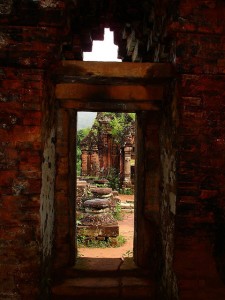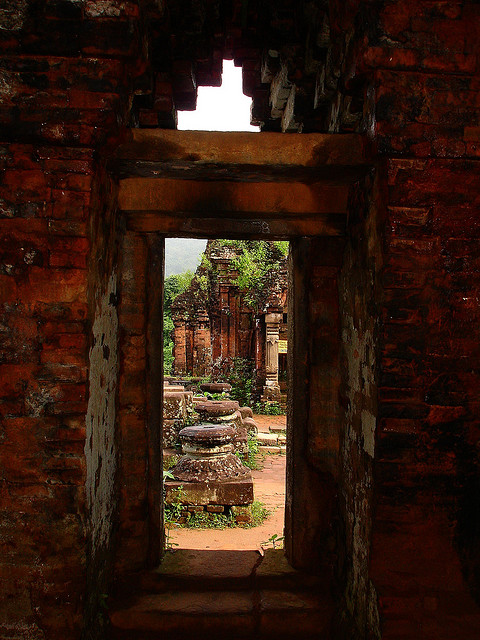
It’s eight a.m. and our car is winding it’s way uphill through a cold, grey drizzle.
In the damp of the morning, we’ve passed silently through a strange landscape that shifts unexpectedly from the impossible green of the coffee plantations, to the deep, terracotta orange of the soil that provides the raw material for the local potteries and brickworks.
We’re headed for the ruined temples at My Son, one of the most important religious sites in the Champa Kingdom, an area of central Vietnam which was governed by the Cham dynasties between the second and fifteenth centuries A.D.
My Son (meaning beautiful mountain in Vietnamese) sits in a small valley surrounded by mountains, a location which reflects it’s importance as a Hindu religious site. The Cat’s Teeth mountain, for example, which dominates the site, is said to be home to the Hindu God Shiva, the main deity worshipped by the Cham.
Hinduism infiltrated this area of Vietnam via the commercial ties that were forded between the Vietnamese ports of Hoi An and De Nang, and India; commercial beginnings which nevertheless helped form a major Hindu culture.
In My Son, the temple layout itself is a reflection of Hindu cosmology. A main central tower symbolises the sacred Hindu mountain, Meru, at the centre of the universe, while the square or rectangular base represents the human realm or the world.
The original buildings would have been made of wood, none of which survive today. From the seventh century, however, until the end of Cham culture in the 1470s, brick became the primary construction material.
Mortar made from a mixture of natural resins was used to bind the bricks, a technique which served to protect the masonry from the infiltration of water and humidity.
This ingenious engineering prowess could not stop My Son from falling into disrepair with the fall of the Champa Kingdom however, and for centuries the site was left to slowly disintegrate among the ever encroaching jungle.
It was only with their rediscovery by French soldiers in 1895 that the first archaeological research was undertaken by the École Française d’Extrême Orient and the significance of the site understood.
Subsequent political unrest in the region and the outbreak of war ensured that no significant work was conducted in My Son from the 1930s onwards, and it was only with it’s designation as a Unesco world heritage site in 1999, that a reappraisal of its cultural and historical importance, was finally secured.
That My Son has survived at all, is nothing short of a miracle.
While the centuries of neglect and theft have clearly taken their toll, the most severe damage occurred during the Vietnam War.
After the Tet offensive, this area was used extensively by the Vietcong and as a result was heavily bombarded by US forces.
So to walk around the site today is to walk around a very melancholy place. Bomb craters dot the site and bullet holes pockmark the brickwork. The gilded roofs have long since collapsed, replaced with a wild growth of unruly plants, and cracks are forming in some of the remaining towers, leaving them in danger of imminent collapse.
I think it is the violence of the destruction, the fact that some of the damage was inflicted through war and bombs, rather than natural erosion and decline, that makes the place seems so forlorn.
There’s a sense of “what if” about it. A sadness that such destruction is possible. A wistful desire for the damage not to have been inflicted.
It leaves you wandering around imagining how would those structures look now. Leaves you piecing together a vision of the place as it once was, from the tantalising glimpses that remain in the ruins. From the fading Sanskrit inscriptions etched into the stone, from the intricately carved windows or the fallen statues. Glimpses which tell of a rich and fascinating past.
Today, Unesco and the Vietnamese authorities are working hard to halt any further catastrophic decline and preserve Cham history at My Son.
And not a moment too soon.
